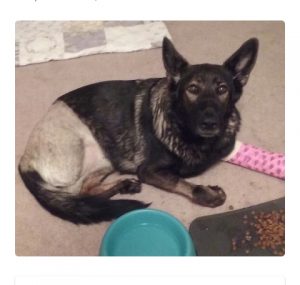With the 4th of July right around the corner, what better time to remind pet parents of common summertime pet hazards? You can find numerous on-line articles regarding hazards, so I’ll focus on what, in my 30+ years in animal welfare, appear to be the most problematic ones.
Ticks are considered one of the biggest dangers to pets that are allowed outside, not because the tick itself will harm your pet, but because they carry numerous diseases, including Lyme disease. If you have a pet that is allowed outdoors, be sure to check for ticks on a regular basis, and be aware that these nasty, little buggers have a way of escaping detection, especially in long or thick-furred animals. If you do find one, consult your veterinarian or follow the ASPCA’s recommendations for removal – https://www.aspca.org/pet-care/general-pet-care/fleas-and-ticks.
We’ve all heard horror stories about pets left in hot cars dying, yet every summer, more tragedies occur. To my mind, it’s simple. If you’re going someplace where you can’t take your pet inside with you, LEAVE THEM HOME! Enjoying the human-animal bond is all well and good, but not if you kill your animal in the process. It only takes a matter of minutes for the temperature inside a car to rise high enough to endanger the life of your pet. And, I’m not just referring to very hot days in the 90’s and above. When the temperature outside is 70 degrees, a nice day for humans, the temperature inside your car can rise to 104 degrees in less than 30 minutes. Why take the risk?
Hot concrete is not something we think about when dragging our dogs out to a street festival or a long walk. After all, they originated living outdoors and must be impervious to extreme weather conditions, right? Wrong! A good rule of thumb to use is if the ground is too hot for you to go barefoot, it is too hot for your dog or cat’s sensitive pads. Pets can and do suffer burns to their feet which are painful and usually require veterinary intervention to heal. Stay on the grass, invest in pet booties, or walk during cooler times of the day. When all else fails, leave your pet at home with plenty of cool drinking water and enjoy the street festival with your human friends.
Last, but definitely not least in my book, is fireworks. Most of us enjoy fond childhood memories of fireworks on the 4th. But for pets who are afraid of loud noises, this holiday can literally prove deadly. DO NOT take your pets to a fireworks display. They can panic, break away from you, and either get lost or get hit by a car. Also, please do not underestimate the amount of fear pets can experience. There is nothing cute or funny about a dog running around the house in terror during a loud thunderstorm or fireworks show. They are dealing with a phobia that at the very least requires your intervention – putting them in a safe part of the house where the noise is minimized, investing in a compression vest, remaining by their side for reassurance – and at worst, requiring veterinary intervention in the form of prescription medication.
So, why do I consider fireworks to be such a huge pet hazard? In addition to running B&B Creations, I also run a safety net charity called Harley’s Hope Foundation. Our focus is on keeping pets and their people together, which we do through a variety of services. One of those services is financial assistance with major/emergency veterinary care. Several years ago, we had a client apply for help with her German Shepherd, Willow. While the client was at work on the 4th of July, Willow was home alone and freaking out over the noise created by a local fireworks show. She was so panic-stricken, Willow pushed through the screen on a third floor window and plunged to the ground below. She lost one rear leg to amputation and the client applied to HHF for help with surgery on a broken front leg. If it couldn’t be fixed, Willow would have been euthanized. This client learned the hard way that it is important to pay attention to what your pet is telling you through their body language and actions, and to make accommodations in your home environment or schedule to help them cope.

Willow resting after her July 4th injury.
Don’t wait until you are facing a tragedy like the one that Willow experienced to learn more about their fears. There is plenty of information and suggestions out there, including the fact that catnip can help dogs with mild anxiety. I stress mild because Willow experienced full-blown panic and catnip would not have helped in that situation. But, if your dog experiences mild uneasiness about going in the car or being left home alone, try a dose of catnip in their favorite food or treat. It takes about 45 minutes for herbs to enter the bloodstream, so while catnip may not be a quick “cure” for your situation, it can definitely be a handy tool to include in the toolbox.


